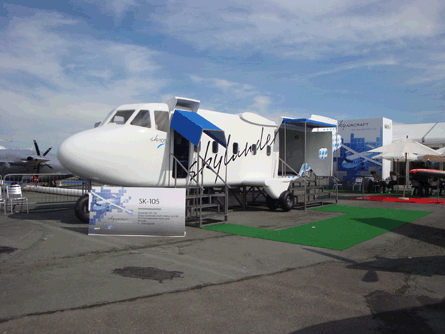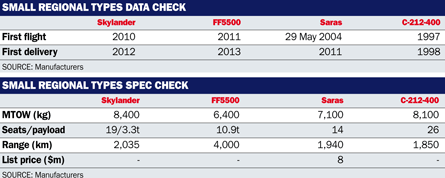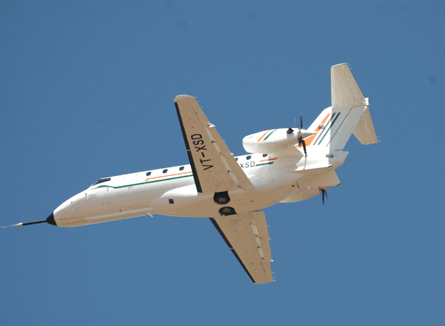During the summer, France-based GECI International marked a new phase in its aim to maintain a presence in the light utility twin-turboprop market. In June, it set up GECI Aviation and signed a memorandum of understanding for the supply of the F406 NG, developed by Reims Aviation, and the Skylander SK-105, designed by Sky Aircraft in Chambley, France.
The company signed the MoU with a private Malaysian aviation group for the delivery of five F406s, for maritime surveillance and cartography, together with four Skylander SK-105s, in commuter and cargo versions.
Another MoU was also signed with Bob Crowe Aircraft Sales for one F406 in its commuter/cargo configuration, plus options for a further two aircraft.
 |
|---|
© Max Kingsley-Jones/Flightglobal |
INITIAL DELIVERIES
The 10 aircraft are worth more than $60 million. The nine-passenger F406s are due for delivery in the second quarter of 2010, with initial deliveries of the larger Skylander scheduled for the third quarter of 2012.
The Skylander SK-105 was finally launched on 4 September 2008 by GECI International, with support from the French government. Originally planned to be assembled in Evora, Portugal, a production site for the Skylander is now being established on a former NATO military base at Chambley-Buissières in the Lorraine region of France.
The first flight is due in 2010, with certification in the CS23/FAR23 commuter category, and service entry in 2011.
Turkish freight carrier ACT Airlines, which signed a letter of intent for 15 aircraft in early 2008, is due to take delivery of the first batch of aircraft.
According to GECI International, ongoing negotiations for sales cover 180 aircraft, including 70 F406s and 110 Skylanders.
Powered by two 1,100shp (820kW) Pratt & Whitney Canada PT6A-65B turboprops driving five-blade Hartzell propellers, the high-wing, unpressurised, fixed landing gear Skylander is capable of carrying 19 passengers or 3.4t (7,500lb) of cargo.
Envisaged uses include commuter, passenger/cargo combi, freight and paratroop transport. It will also be available in aerial ambulance configuration.
Claimed advantages over similarly sized aircraft are low acquisition and operating costs, long range, short take-off and landing from unprepared airstrips, and a glass cockpit.
Of similar external configuration, but substantially larger, is Freight Feeder Aircraft's FF5500. Specifically designed as a utility air freighter, it is now also marketed as a multi-mission military variant - the dedicated FF5500MW.
This can be used as transport for 40 combat troops with full gear, a medevac aircraft with 24 stretchers or as a mobile field hospital. It will also have in-flight refuelling capability.
HIGH PAYLOAD
The high-wing turboprop aircraft is said to offer the lowest cost per t/km and the highest payload capacity of any aircraft in its class today, with design advantages claimed to include its non-pressurised cargo bay, rugged fixed landing gear, proven off-the-shelf components, and the ability to integrate standard industry containers.
The aircraft has a maximum design range of 4,000km (2,175nm), with a payload of 10,000kg (22,000lb), and can operate from runways of less than 1,050m (3,500ft).
Also still under consideration is the FF4400, which has the same fuselage cross-section, but a shorter cabin. The targeted market niche includes the overnight/two-day express airlines, postal services, passenger/cargo airlines, and the fast-growing third-party logistics companies.
Freight Feeder Aircraft, which acquired the aircraft technology and development programme from Utilicraft Aerospace Industries in December 2007, is accelerating construction of the prototype at Metalcraft Technologies (MTI) in Cedar City, Utah, USA for a first flight in early 2011.
In July this year, Freight Feeder Aircraft and MTI entered into a joint-venture agreement, under which MTI will contribute assistance with labour, engineering support and programme management, with a ultimate goal of reducing prototype construction costs by some 33%. In exchange, MTI will receive a "life of programme" contract to manufacture and assemble the FF5500 fuselage.
The 30-month development plan would suggest that US Federal Aviation Administration Part 25 certification will be achieved towards the end of 2013, by which time production of the first 30 aircraft will be nearing completion.
The company estimates the potential global market for this type of aircraft to be around 5,000 aircraft, of which it hopes to capture a 15% market share - 750 aircraft - over the next 15 years. Production rate is expected to be 60 aircraft per year.
Freight Feeder Aircraft believes that existing aircraft, most of which were not designed specifically as pure freighters, "pose little competitive threat" to the market segment of the FF5500.
Work on India's indigenous 14-seater Saras twin-turboprop pusher design, developed by the state-owned National Aerospace Laboratories (NAL), started as long ago as 1991, but the aircraft did not make its first flight until 29 May 2004.
 |
|---|
Certification to FAA Part 25 was planned for late 2009, but a fatal crash of the second prototype (PT-2) near Bangalore on 6 March 2009, killing three air force pilots, may have pushed this back by up to two years and will have done little to endear the aircraft to would-be customers.
Indian defence ministry officials, however, maintain that the Saras will be bought by the country's defence forces. The Indian air force has expressed an interest in acquiring 15 aircraft, and the Indian coastguard is in addition considering using the Saras as a Dornier 228 replacement.
NAL projects will demand 250 aircraft during the course of the next 15 years, which will include variants for commuter, cargo, ambulance, executive, border control and military transport operations.
Until the cause for the crash has been ascertained, the first prototype PT-1 has been grounded, but work continues on prototype PT-3, which will make greater use of composites to reduce the aircraft weight by some 500kg and bring it closer to its desired design weight of 7,100kg.
PT-3 will be to full production standard and will be powered by the 1,200hp Pratt & Whitney Canada PT6A-67A turboprops, the same as those fitted to the crashed PT-2.
 |
|---|
© Vladamir Karnozov |
The continuing delays to the Saras programme will also affect plans to produce a larger 25-seat Saras-S, and could have an impact on longer-term joint efforts between NAL and Hindustan Aeronauticsfor the 70-seater RTA-70 regional transporter.
NOMADS AND OTHERS
Australian company Gippsland Aeronautics, which manufactures the piston-powered GA8 Aerovan eight-seater, of which some 140 are in service worldwide, is planning to resurrect the twin-engined N24 Nomad utility aircraft in 2011.
The Victoria-based manufacturer acquired the type certificate and all intellectual property rights to the aircraft from Boeing Australia in June 2008.
The 16-seat Next-Generation Nomad will be powered by new Rolls-Royce 250-B17F/1 turboprop engines with Hartzell propellers and will feature glass cockpit technology, greater operating efficiencies and safety.
Single-pilot operation will increase its appeal to potential operators. A market study commissioned by Gippsland Aeronautics suggests a potential market for 170 Next-Generation Nomads, the same number that were built until production ceased in 1984. The company is believed to already have received several letters of intent for the latest Nomad.
The EADS CASA C-212 is of the same vintage as the Nomad, having first flown in 1971, but it continues to soldier on. The transfer of production and assembly of the latest C-212-400 version from Spain to Indonesian Aerospace in Bandung will be completed in January 2010.
IAe will eventually have the capacity to produce 12 aircraft a year, with the first scheduled to be completed in 2011.
The first firm order for one Series 400 was received in February 2009 from Airfast Indonesia, following on from a 2008 MoU from Indonesian domestic airline Merpati Nusantara for 10 aircraft.
IAe also continues to build the earlier C-212-200, but with orders dwindling to a trickle, this type could well be phased out in favour of the newer model.
The high-wing Series 400, which entered service in 1998, is powered by two Honeywell TPE331-12JR-701C turboprop engines and can seat 26 passengers in its box-like cabin, or 24 passengers plus toilet facilities.
The aircraft's target market is the civil utility passenger/cargo sector, as well as the multi-mission military arena. Only four of the larger 45-seater CN-235 regional airliners remain in airline service, although it continues to be produced for the military.
In limited production is the Polish-built PZL Mielec M28 Skytruck, a high-wing, PT6A-65B-powered 19-seater utility STOL aircraft, certificated by both the European Aviation Safety Agency and the FAA.
The aircraft has made more impact in its military guises and, although an offset agreement, following Poland's acquisition of the Lockheed Martin F-16, stipulates the sale of 100 M28s in North America and the Caribbean over the next 10 years, substantial civil sales appear unlikely.
The US Air Force Special Operations Command received 10 M28s in June.
Source: Flight International
















